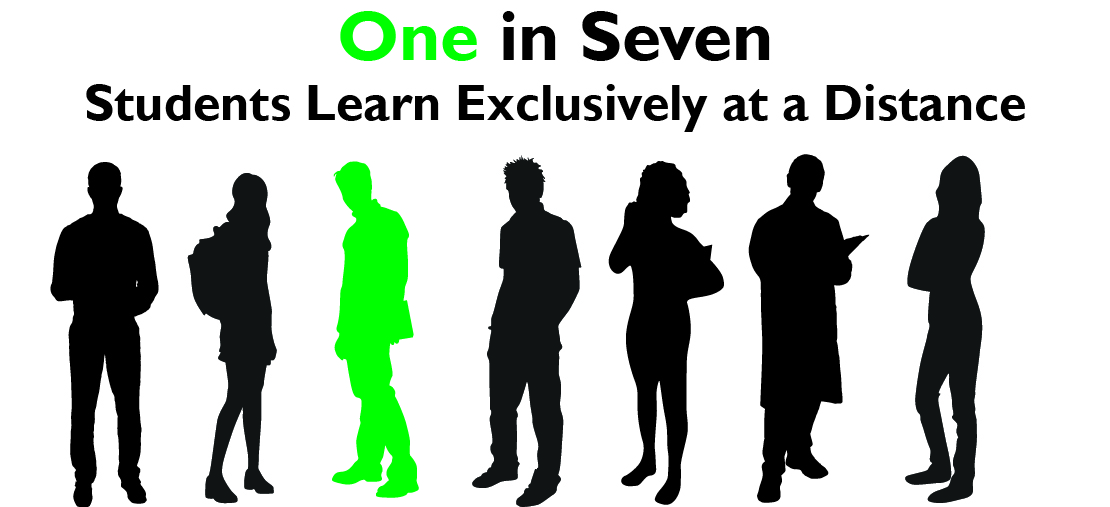Need Your Input: What Matters to You in Counting Distance Education Activities?
Published by: WCET | 8/17/2017
Tags: Completion, Data And Analytics, Distance Education, IPEDS, Survey, U.S. Department Of Education
Published by: WCET | 8/17/2017
Tags: Completion, Data And Analytics, Distance Education, IPEDS, Survey, U.S. Department Of Education
It is said that we count what we value.
It is also said that not everything that can be counted has value.
Can you help tell the difference when measuring distance education activities?
The U.S. Department of Education needs your help in discerning what data it should be collecting about distance education and hybrid/blended learning. In a call for comments, they seek advice from interested stakeholders on how they might improve the quality of data collections for its Integrated Postsecondary Education Data System (IPEDS).
WCET is proud to partner with Babson Survey Research Group and e-Literate in examining the IPEDS distance education enrollment data under our joint Digital Learning Compass umbrella. But, today we would like to get your opinions. I will summarize some of the options that they are considering. You can choose to submit a comment on your own. Alternatively, you can send brief comments to me and we will compile them to submit. See details below on how to participate in either option. You don’t need to comment on every item.
The panel discussing proposed changes raised great questions. However, there are times when you can tell that the panel needed more experience on distance education issues. Here’s your chance to help.
From the call for comments:
“Since 2012, the IPEDS data collection system collects data on distance education in three survey components: Institutional Characteristics (IC), Completions, and Fall Enrollment (EF). The purpose of these data is to provide useful and meaningful information on distance education offerings and enrollments for consumer, research, and transparency purposes.”
They also include the insightful footnote:
“Although the IPEDS distance education data collection is relatively new, the postsecondary landscape is constantly changing due to advanced and improved technologies.”
Distance education courses.
IPEDS currently has no definition for a hybrid or blended course. The IPEDS definition of a “Distance Education Course” focuses on almost all of the activity in the course taking place “exclusively via distance education.” The definition is:
“A course in which the instructional content is delivered exclusively via distance education. Requirements for coming to campus for orientation, testing, or academic support services do not exclude a course from being classified as distance education.”
The preliminary recommendation from the panel considering changes is:
“IPEDS should retain its current definitions of exclusively online coursework to maintain longitudinal comparisons with past data collections and should emphasize in the instructions that hybrid courses are not considered by IPEDS as distance education.”
What do you think? How would you improve this definition?
Distance education programs.
The IPEDS definition of a “Distance Education Program” builds on the course definition, seemingly, to focus on exclusively at a distance, as well. The definition is:
“A program for which all the required coursework for program completion is able to be completed via distance education courses.”
The preliminary recommendation from the panel considering changes is:
“Panelists…pointed out that distance education programs are generally approved by accreditors and suggested adding language to the question to clarify that all programs are designed to be completed via distance education. This would eliminate confusion between distance education indicating course-taking practices versus distance education describing the program being offered. They also suggested that NCES review the definitions of distance education programs used by accrediting agencies and consider adopting similar language.”
They are struggling with this one. What would you suggest? Would you include SARA and states in the conversation?
Distance education levels.
The panel suggests that institutions report their offerings according to the follow table with the newest column on the far right in red:

How would you improve this chart?
Exclusively distance education programs.
See page four of the call for comments for this one. The summary completely confused me. Perhaps you will have better luck. It leads me to the question: I can think of “completely distance education” institutions (those that offer all their courses at a distance), but can you think of an institution that either:
Telecommunications systems.
Panelists discussed whether to collect data on the types of technology used in distance education. Their preliminary recommendation is:
“In general, they agreed there was no compelling reason to begin collecting detail on telecommunication systems.”
Do you agree?
Delivery modes.
Panelists discussed whether to collect data on synchronous, asynchronous, or mixed modes of instruction. Their preliminary recommendation is:
“…they pointed out that the mode of delivery varies by course section and collecting this information at the institution level would not be feasible.”
Do you agree?
Here’s a description of the problem they identified:
“The IPEDS Completions component collects whether the institution offers the full program (as defined by the Classification of Instructional Programs [CIP] code system) and award level through distance education. If more than one program is offered under a CIP code by award level, institutions are instructed to check “yes” to the distance education question if any of the programs are offered as a distance education program. Panelists noted that a constraint of the current format is the inability to identify the number of programs offered as distance education programs if more than one program is offered under a CIP code. They considered several options for categorizing exclusively distance education programs in ways that are better aligned with how institutions organize their programs.”
The options considered:
The preliminary recommendation of the panel is:
“After weighing the burden of collecting the additional data with the benefit it would provide to the public, panelists did not strongly favor modifying the Completions component question about programs offered via distance education.”
Would you like to see completions data or is it too burdensome? If you would like to add it, how would it help you?
Clarify terminology.
The preliminary recommendation of the panel is:
“Panelists suggested relabeling the category for “enrolled in some but not all distance education courses” to “enrolled in at least one but not all distance education courses” to reduce misunderstandings about “some” distance education coursework on the EF component to mean hybrid courses.”
Collect distance education enrollment in the 12-month Enrollment survey (in addition to the Fall Enrollment survey).
Since some distance education institutions enroll students continuously throughout the year, the current Fall Enrollment report might disadvantage them. The 12-month Enrollment survey might better reflect total institutional enrollments. The preliminary recommendation of the panel is:
“Panelists did not reach agreement on the value of collecting distance education instructional activity or calculating distance education FTE estimates, given the high burden and questions about who would benefit from these data. Panelists suggested that NCES review information on instructional activity required by accreditors to further assess the burden and feasibility of collecting data on distance education instructional activity.”
It would be great to hear from institutions with non-traditional calendars. How would this option help you? For those with traditional calendars, is this a help or a burden?
Collection of hybrid/blended enrollments or activities would be new for IPEDS. It is obvious this discussion could have been aided by someone with more experience with technology-mediated instruction. The preliminary definition and recommendations of the panel are:
“In general, panelists voiced opposition against attempting to use percentage thresholds to define what a hybrid course is and instead suggested using the following definition as a framework for the discussion: hybrid courses are courses that can be taken through some distance education technology that replaces in-classroom seat time. Panelists suggested collecting the number of students enrolled exclusively in hybrid courses, in at least one but not all hybrid courses, or not enrolled in any hybrid courses, by student level and undergraduate degree-seeking status, to mirror the “all, some, or none” format for collecting enrollment in distance education courses.
A panelist also noted that the concept of seat time is not applicable to competency-based education courses, in which the outcome rather than the seat time is the focus, and discussed implementing an exception, or specific instructions, to guide institutions on how institutions should report competency-based education courses.
In general, panelists supported collecting hybrid enrollment in both the EF and E12 components, but RTI encourages additional comments on this topic, particularly with respect to burden on affected institutions.”
What is your recommendation regarding hybrid/blended courses…both in how they are defined and on the value of having such data?
The panel considered:
“The panel was asked to weigh the possibility of adding a new, optional survey component to IPEDS for collecting and reporting consumer-focused distance education information. For example, the panel considered an approach that would focus on attributes related to each CIP code and award level to collect the data for search tools for prospective students.”
The panelists suggested that, if this options is pursued, that consumer focus groups be used to identify useful data items. Additionally, date would be provided in an application provider interface (API) for use by outside organizations.
Again, you can respond to any or all the items. You have two options:
Let’s make sure that whatever we count, that it makes sense and is useful. Your input will help assure that outcome.
Thank you,
Russ
Russ Poulin
Director, Policy & Analysis
WCET – WICHE Cooperative for Educational Technologies
rpoulin@wiche.edu
